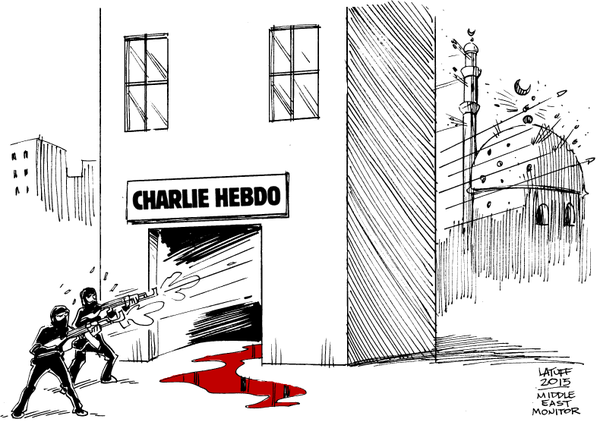Sam Harris is very sure that Islam created ISIS, and he criticized President Obama for saying otherwise:
As an atheist, I cannot help wondering when this scrim of pretense and delusion will be finally burned away—either by the clear light of reason or by a surfeit of horror meted out to innocents by the parties of God. Which will come first, flying cars and vacations to Mars, or a simple acknowledgment that beliefs guide behavior and that certain religious ideas—jihad, martyrdom, blasphemy, apostasy—reliably lead to oppression and murder? It may be true that no faith teaches people to massacre innocents exactly—but innocence, as the President surely knows, is in the eye of the beholder. Are apostates “innocent”? Blasphemers? Polytheists? Islam has the answer, and the answer is “no.”
If indeed Islam itself demands that all apostates must die, it’s been weirdly inconsistent about this over the years. Just yesterday I found an article about Muslims who risked — and sometimes lost — their own lives saving Jews from the Holocaust. Harris would probably argue those Muslims were hypocrites (No True Muslim would rescue a Jew?). But I’m sure if we checked we could probably find many examples of amicable meetings between Muslims and non-Muslims that didn’t end in slaughter.
Maybe the relationship between Islam and violence is not what Harris assumes.
In Rethinking Religion I devote a chapter to religious violence and another to the dynamics of mass movements. In the latter chapter I propose that many of the supposed evils of religion — a propensity to violence and dogmatic faithfulness to irrational beliefs — can be found in many kinds of movements, both religious and not religious. And I propose that violent movements of all sorts have two things in common — a “holy” cause combined with a fanatical grievance.
The holy cause does not have to be religious; patriotism will do nicely, too, especially when combined with belief in ethnic or racial superiority or some kind of glorious national destiny. But the fanatical grievance is an essential component, also. I postulate that people who do not feel particularly aggrieved about anything tend to be disinclined to become violent about their holy causes, whether religious or not.
At Alternet, C.J. Werleman addresses atheists’ flawed view of Islamic terrorism. In particular, he addresses Sam Harris’s insistence that terrorism by Muslims is driven entirely by Islam. Werleman documents that a great many factors other than Islam have been driving terrorism in Muslim countries, and all of this supports my “fanatical grievance” hypothesis. This is not to say that religion is not a factor, but it is not the simple and direct factor that Harris imagines.
At Foreign Policy, anthropologist Scott Atran writes,
… the chief complaint against religion — that it is history’s prime instigator of intergroup conflict — does not withstand scrutiny. Religious issues motivate only a small minority of recorded wars. The Encyclopedia of Wars surveyed 1,763 violent conflicts across history; only 123 (7 percent) were religious. A BBC-sponsored “God and War” audit, which evaluated major conflicts over 3,500 years and rated them on a 0-to-5 scale for religious motivation (Punic Wars = 0, Crusades = 5), found that more than 60 percent had no religious motivation. Less than 7 percent earned a rating greater than 3. There was little religious motivation for the internecine Russian and Chinese conflicts or the world wars responsible for history’s most lethal century of international bloodshed.
Indeed, inclusive concepts such as “humanity” arguably emerged with the rise of universal religions. Sociologist Rodney Stark reveals that early Christianity became the Roman Empire’s majority religion not through conquest, but through a social process grounded in trust. Repeated acts of altruism, such as caring for non-Christians during epidemics, facilitated the expansion of social networks that were invested in the religion. Likewise, studies by behavioral economist Joseph Henrich and colleagues on contemporary foragers, farmers, and herders show that professing a world religion is correlated with greater fairness toward passing strangers. This research helps explain what’s going on in sub-Saharan Africa, where Islam is spreading rapidly. In Rwanda, for example, people began converting to Islam in droves after Muslims systematically risked their lives to protect Christians and animists from genocide when few others cared.
So, evidence suggests religion can bring out the best in us as well as the worst. I propose that without the “fanatical grievance” factor, religion by itself is unlikely to cause people to go to war. An emotionally healthy and reasonably contended individual does not become a mass murderer because of something he reads in scripture, no matter how devout he is.
Religion does not exist in a vacuum. All religions live and grow within a culture of, well, culture. And politics, and society, and history. These things exist together and condition each other in countless ways. Sometimes culture expresses itself through religion. Sometimes religion expresses itself through culture. Sometimes it’s hard to tell where one ends and the other begins. Religious identity often gets mixed into ethnic or national identity, so that “defending the faith” becomes synonymous with “defending my people.”
Very often the factors that push a movement toward violence may have little to do with religion, but at some point in the process religion is trotted out to justify whatever extreme measures are used to achieve ends. More often than not, the truth of this isn’t apparent even to the people fomenting the violence. Religious violence often begins when people become angry or fearful about something, and as a desire to strike the feared or hated thing grows, religion provides a great moral cover for whatever violent impulses want to be expressed. Persuading yourself that you have been anointed to do God’s terrible work makes it much easier to light the fuse or pull the trigger.
Religion, then, is not the root cause of violence as often as it is an accelerant. Scott Atran writes,
Although surprisingly few wars are started by religions, once they start, religion — and the values it imposes — can play a critical role. When competing interests are framed in terms of religious and sacred values, conflict may persist for decades, even centuries. Disputes over otherwise mundane phenomena then become existential struggles, as when land becomes “Holy Land.” Secular issues become sacralized and nonnegotiable, regardless of material rewards or punishments.
We can see from our own home-grown fundamentalists that all kinds of unrelated things can become sacralized. Some American conservative Christians have sacralized capitalism, for example, to the point of claiming free-market capitalism is ordained by the Bible.
As Karen Armstrong and other scholars have documented, religious fundamentalism is primarily a backlash against modernity. The original Christian fundamentalist movement arose in the late 19th century United States in reaction to a spectrum of social and cultural challenges, such as the huge influx of immigrants, many of which were barely connected to religion.
In the broader sense of the word, “fundamentalist” religious movements around the world are reactionary. They tend to be obsessed with creating some kind of sacred enclave where they can be in complete control and free of outside influence. Often, as in the case of ISIS, they venerate a highly mythologized version of the past that they say they want to restore. They place great importance on sacred symbols and moral purity, especially the moral purity of women. But they also tend not to follow their own religions in any kind of holistic way. Any parts of their own doctrines or scriptures that do not support their violent path, such as teachings on mercy and compassion, are studiously ignored.
So, whether Sam Harris likes it or not, there is a solid argument to be made that the root cause of ISIS is not Islam, and that instead Islam has been appropriated to serve as packaging for a veritable compost heap of grievances mostly related to politics and oil. That said, the extent to which the ISIS movement can persuade itself its cause is holy will have a lot to do with how long and hard and effectively the group will survive and keep fighting. So Islam cannot be ignored.
At the same time, it can be argued that what’s fueling ISIS is more of an idea of Islam than Islam itself. Rather than a practice of humble submission to the will of God, this idea of Islam exalts and empowers the leaders and followers of ISIS. And while it’s not up to me to judge what is “true” Islam and what isn’t, I respect arguments that the ISIS version aint’ it.
But Sam Harris says he knows better.
Understanding and criticizing the doctrine of Islam—and finding some way to inspire Muslims to reform it—is one of the most important challenges the civilized world now faces. But the task isn’t as simple as discrediting the false doctrines of Muslim “extremists,” because most of their views are not false by the light of scripture. A hatred of infidels is arguably the central message of the Koran.
The Qu’ran is not my area, but I doubt it’s Sam Harris’s area, either. Harris’s words smack more of bigotry than scholarship. Obviously, Harris has a deep ego-investment in the belief that Religion Is Bad, and that good ol’ confirmation bias backs him up every time. I doubt that his mind could be opened to entertain another view. And that’s why he’s mostly clueless.
Making Islam the enemy is the last thing we should be doing now. For another view, see Salam Al Marayati, “The Key to Defeating ISIS Is Islam.”
Religious violence is a complex topic. Sometimes religious institutions have made cold-blooded decisions to betray their own doctrines and engage in violence, and this is usually related to either ensuring the institution’s survival or spreading its influence. But examples of this kind of violence have become less common in the modern era, and I don’t know if it applies to any violence going on in the world now.
What I do know is that responses to religious violence coming from a place of knee-jerk bigotry and ignorance are not going to help us deal with it.
Read more about religious violence in Rethinking Religion: Finding a Place for Religion in a Modern, Tolerant, Progressive, Peaceful and Science-affirming World .
.


